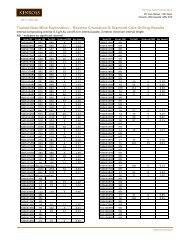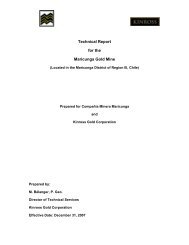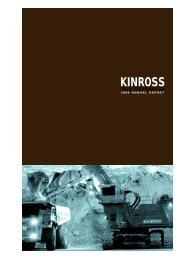Technical Report for the Fort Knox Mine - Kinross Gold
Technical Report for the Fort Knox Mine - Kinross Gold
Technical Report for the Fort Knox Mine - Kinross Gold
Create successful ePaper yourself
Turn your PDF publications into a flip-book with our unique Google optimized e-Paper software.
<strong>Fort</strong> <strong>Knox</strong> <strong>Mine</strong> <strong>Technical</strong> <strong>Report</strong>14.0 DATA VERIFICATIONAll drill data, including collar locations, down-hole surveys, and data intervals arecollated in Excel spreadsheets. Survey and log data are hand-entered into <strong>the</strong>spreadsheets, while assay data are downloaded in digital <strong>for</strong>mat from <strong>the</strong> assay lab <strong>the</strong>nsubsequently merged into <strong>the</strong> spreadsheets. Collar locations are initially recorded in <strong>the</strong>local grid by <strong>the</strong> GPS surveying system. Collar locations and downhole surveys are alsorigorously reviewed via manual verification methods <strong>for</strong> erroneous data by <strong>the</strong> technicalstaff of FGMI. Following input of data into Excel spreadsheets, <strong>the</strong> data are output to a<strong>Mine</strong>Sight-ready ASCII file and subsequently imported into <strong>the</strong> <strong>Mine</strong>Sight softwarepackage. The resulting assay and survey files in <strong>the</strong> <strong>Mine</strong>Sight directory include:Assay file is identified as knx011.07d and,Survey file is named knx012.07d.<strong>Gold</strong> grade and lithology data are entered into <strong>the</strong> “au1” and “lith” fields within <strong>the</strong> assayfile. The majority of <strong>the</strong> drillhole data has had a minimum of 10% double-entry checksper<strong>for</strong>med <strong>for</strong> data validation purposes.The processes of data verification as described above are acceptable due diligenceroutines to assure <strong>the</strong> reliability of <strong>the</strong> <strong>Fort</strong> <strong>Knox</strong> data set. The authors feel com<strong>for</strong>tablethat <strong>the</strong> presented data reflect actual conditions of <strong>the</strong> in-situ situation.14.1 Drill Hole Data RejectionTwelve RC holes displayed down-hole contamination when compared to adjacent holes,blast hole drilling, and <strong>the</strong>ir respective drill logs, and select intervals were rejected from<strong>the</strong> assay data set. <strong>Gold</strong> values <strong>for</strong> <strong>the</strong> rejected data were converted to -1 (as if missing).This process resulted in <strong>the</strong> rejection of 806 intervals. Prior to 2004, computer programsrecording down hole “cyclicity” and “decay”, as well as excessive sample weight, wouldbe used as guides <strong>for</strong> geologists to reject suspect intervals as aberrant gold values. Asmining production has progressed and production blastholes have allowed <strong>for</strong>verification of <strong>the</strong> presence of gold, <strong>the</strong>se rejected intervals have been reviewed and45
















